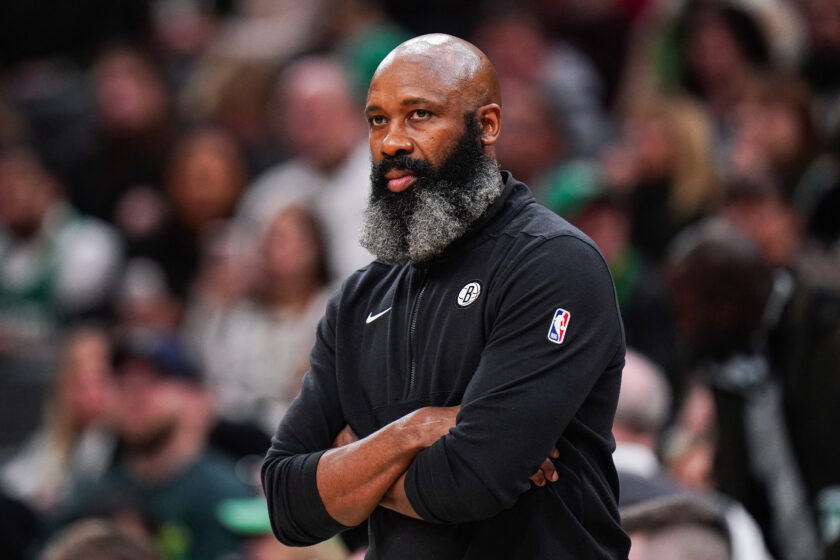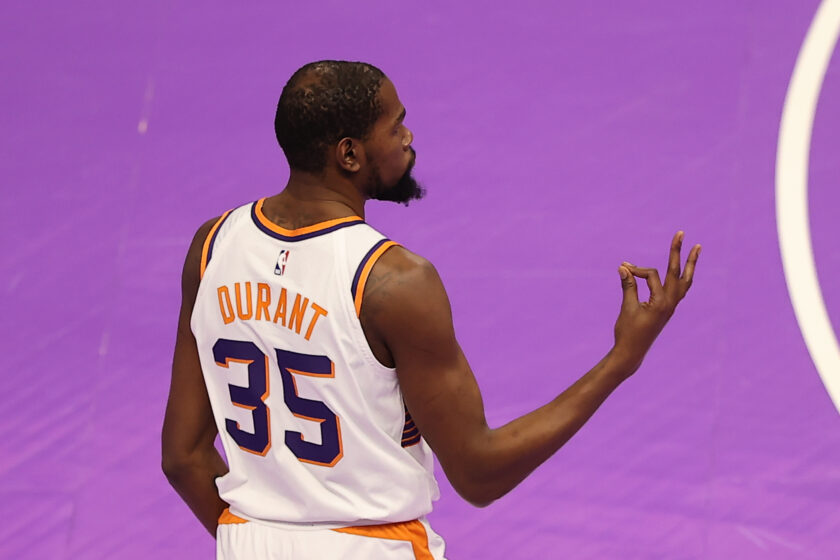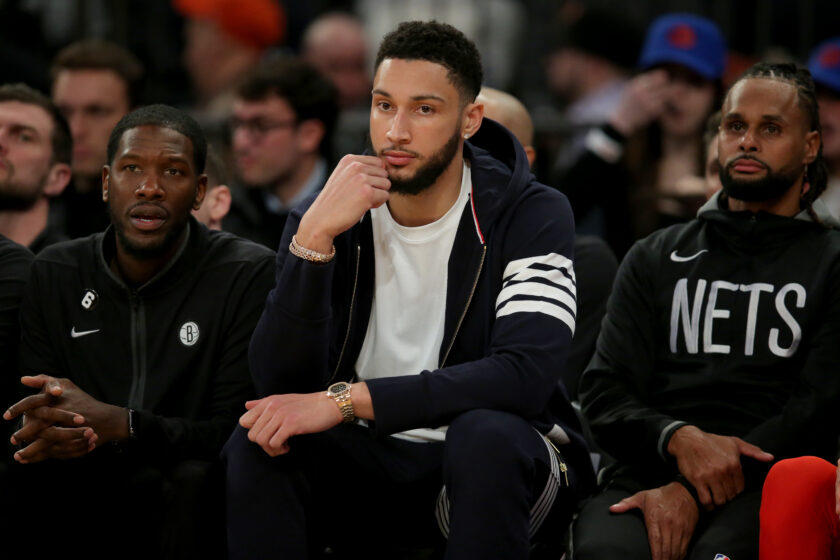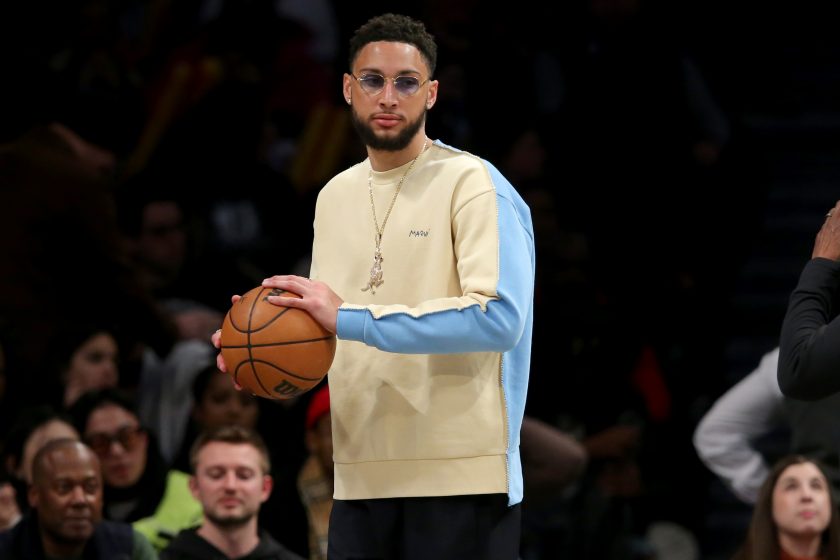Brooklyn Nets: We’re finally seeing who D’Angelo Russell can become

At long last, D’Angelo Russell is showcasing his limitless potential as a playmaker for the Brooklyn Nets.
D’Angelo Russell has always been looked at as a unique but cerebral basketball player.
The appeal of Russell’s game wasn’t recognized immediately. He was a somewhat overlooked prospect in high school, ranked 30th in his recruiting class.
It doesn’t matter. What D’Angelo Russell is doing now is proving is actual NBA worth. It’s coming.
D-Lo burst upon the scene during his first (and only) season at Ohio State University. During that freshman season, Russell averaged 19.3 points per game, 5.7 rebounds, and 5.0 assists highlighted by 44.9 percent shooting from the field and 41.1 percent from three.
He put together one of the best freshman seasons since, perhaps, Anthony Davis, winning Big Ten Freshman of the Year and gaining recognition as a first-team All-American.
College success catapulted him up NBA draft boards, as most analysts regarded him as a top-five pick.
D’Angelo Russell’s style was looked at as both distinctive and slippery — his NBA comparison, according to NBAdraft.net, was Brandon Roy — a player whose game is rarely juxtaposed to due to his idiosyncrasies.
Russell was selected by the Los Angeles Lakers with the second pick of the 2015 NBA Draft — ahead of the consensus No. 2 pick, Jahlil Okafor.
His rookie season was largely forgettable. D-Lo was placed in a particularly unattractive situation, playing supporting cast to Kobe’s distasteful farewell tour. (If you can’t tell … I’m not a Kobe guy.)
This wasted year prompted many questions about his game and his fit in the big city of Los Angeles.
Things in LA truly boiled over during the infamous Nick Young incident. Now, I’m not going to rehash what has been reported in nauseating extremes. Just know one thing: Russell’s decision to film Young’s private conversation greatly affected his teammates’ perception of him within the locker room.
Russell never really recovered in Los Angeles. In his sophomore season, he put up modest averages of 15.6 points and 4.8 assists before being shipped off to Brooklyn in a summer salary dump.
Brooklyn offered Russell a fresh start in a low-pressure situation. The Nets were still a bottom-five team, reeling from the Kevin Garnett and Paul Pierce trade that had defined the decade for Brooklyn.
With new teammates and a coach with instilled beliefs, Russell began the 2017-2018 season with a bang. During his first month in Brooklyn, Russell put up a career-best 21 points on 46.6 percent shooting, along with five assists per game.
His strong start continued into November. Again, Russell scored the ball well on a 19.8 point average. His big improvement was his assists, which moved up to 6.6 per game. Russell’s performance did not go unnoticed, and he began to catch buzz as a potential Most Improved Player candidate.
However, Russell’s strong start was cut short. On Nov. 17, Russell was forced to have arthroscopic surgery on a lingering knee injury.
He didn’t make his return until late January of 2018. For the remainder of the season, Russell never really got into his grove. His best month following the surgery was probably March. Although he averaged 15.4 points that month, Russell shot an ugly 39.4 percent from the field.
Once again, Russell’s growth seemed to have been stunted in its tracks.
This was the story of D-Lo’s career – immense potential, disrupted by unforeseen events. First, it was the awkward fit next to the Ghost of Kobe Bryant. Then came the Nick Young mess. When things finally seemed to be going well in a new city, his brief progress was interrupted by injury.
It seemed like D’Angelo Russell’s promising career would never take off.
[sc name=”Nets Center”]Coming into the 2018-2019 season, D’Angelo Russell was looked at by many as the undisputed leader of a youthful Brooklyn Nets team.
Russell’s status as the number one guy was quickly usurped by the third-year wing, Caris LeVert. LeVert took full-reign of the team thanks to his elite hesitation game, and the Nets cruised to a surprising 7-7 start to the season.
Like all good things in Brooklyn, this crashed and burned due to untimely injuries. LeVert went down in particularly gruesome fashion. Because of this, all signs pointed to Russell becoming the de-facto leader.
However, for the second time this season, things didn’t go that way.
To the surprise of many, it was Spencer Dinwiddie who rose from the ashes after an eight-game losing streak. Russell’s backup led the charge during a red-hot December. His elite driving game was on full display throughout the seven-game win streak, and his strong performance prompted a multi-year extension.
Meanwhile, D’Angelo Russell was becoming a bit of an afterthought. During multiple games, coach Kenny Atkinson chose to bench the 22-year-old during the fourth quarter. Many wondered if the 2019 season would be Russell’s last in Brooklyn.
Since Spencer Dinwiddie’s payday, D’Angelo Russell has looked like a different player.
Russell has seen a slight uptick in his shooting percentages since Dec. 6. Over the past month, Russell has shot 44.6 percent from the field. Before that, his field-goal percentage hovered around 40-to-41 percent.
His performance over the past five games has been reminiscent to his strong start of the 2017-2018 season. Russell has averaged 22.2 points, 7 assists, and only 3 turnovers on a healthy 47.7 percent from the field and 35 percent from three.
At long last, a fully healthy and comfortable D’Angelo Russell is showcasing the full extent of his offensive game in a drama-free situation.
With a tight handle and a quick-twitch stroke, D’Angelo Russell’s bread and butter has always been found within the midrange.

At any point in time, Russell has the ability to execute a flurry of crossovers and launch high-arching midrange shots. At just 22-years-old, Russell already has a failsafe counter to tight defenses thanks to that midrange game. Having a reliable finishing move places Russell well ahead of his age curve.
D’Angelo Russell is, by far, the team leader in pull-up shooting. His 8.3 points off of pull-ups almost doubles Spencer Dinwiddie’s second-place 4.4 average.
In fact, D’Angelo Russell’s efficiency ranks within the top 15 of players who take at least four pull-ups per game. Russell’s 42 percent field-goal percentage is nearly identical to the likes of Stephen Curry, Kemba Walker, and Damian Lillard. (Mind you, it also places him in the same class as Rodney Hood, Jordan Clarkson, and the fountain of youth J.J. Barea.)
Since Dec. 13, the date of Dinwiddie’s extension, Russell has only seen his pull-up efficiency climb. Russell’s effective field-goal percentage has moved from 48.8 to 50.9 percent; a mark that is twelfth-best in the NBA.
When it comes to three-point shooting, Russell is a tad inconsistent. On some nights, Russell looks elite from behind the arch (a great example being his recent performance against the Chicago Bulls). On others, he looks completely incapable of getting into a rhythm. Monday’s game against the Celtics was a great example (more on this later).
I have no doubt in my mind that, at some point in his career, D’Angelo Russell will be an effective three-point shooter. Like many dependable shooters, D-Lo gets going via the spot-up.

I’ve been on record for comparing Russell’s shooting form to James Harden’s. The two players are left-handed, and both orient themselves similarly towards the basket. Both Russell and Harden place their left foot well in front of their right when lining up to shoot. Even their follow-through is similar; Harden and Russell tend to splay their legs out after taking the shot.
Similar to Harden, once Russell sees a couple go in, he starts taking increasingly difficult shots. This results in some particularly remarkable makes.

It’s worth noting that Russell’s three-point frequency has gone up dramatically during his recent breakout play. In January, a whopping 51.6 percent of his shots have come from three-point land. This, again, is very Harden-esque. (Over his last ten games, Harden himself has averaged nearly forty points per game while launching 51.5 percent of his shots from three).
Russell has maintained efficiency even with a heightened volume. Over the course of the four January games, D-Lo has taken eight threes per game and made 37.5 percent of them.
Here’s the thing: Russell’s biggest area of improvement has not come from behind the three-point line. It can be found in a different aspect of his game.
D’angelo Russell’s biggest calling card was always his court vision. While giving draft-day grades to the incoming 2015 class, Sports Illustrated’s Chris Mannix had this to say about the young point guard:
“Russell is the best point guard prospect in the draft and the best freshman playmaking prospect in generations. He’s a bonafide floor leader with preternatural passing ability.”
The passing game is where we have seen the most growth from D’Angelo Russell within the last month.
According to tracking numbers, D’Angelo Russell has become one of the best facilitators in the game.
Russell’s 9.1 adjusted assists represent the eighth best mark in the NBA over the past month. Remarkably, Russell’s adjusted assist numbers rank ahead of celebrated playmakers like Rajon Rondo and Chris Paul.
(For those of you who are wondering, adjusted assists are the sum of actual assists, free throw assists, and secondary assists [otherwise known as “hockey assists“]).
Russell has been spraying passes to teammates from all areas of the court. There’s a reason that he’s assisting 39.9 percent of Brooklyn’s baskets.
When it comes to passing the ball, D’Angelo Russell is a fundamentals savant; he loves to utilize the bounce pass.

A majority of Russell’s assists have come from the pick-and-roll. As seen in the video above, Russell prefers to execute bounce passes while in the pocket.
Many times, Russell will use his off-hand to whip the ball to a rolling big man. These are the assists that prompted Kenny Atkinson‘s lofty LeBron James comparison.
Russell’s skillfulness in the pick-and-roll has greatly benefited the team’s centers. Thirty percent of Jarrett Allen’s made baskets have come from D’Angelo Russell passes. Although Ed Davis has logged more total minutes with Spencer Dinwiddie than with Russell, D’Angelo has provided Davis with more assists.
Comparing Dinwiddie and Russell is no easy task; both players excel in different aspects of the game.
When it comes to passing, however, Russell has Dinwiddie thoroughly beat.

Dinwiddie can struggle with accuracy, and will sometimes throw the ball over teammates’ heads.
Russell, on the other hand, will fling passes across the court that land squarely in the hands of spot-up shooters.

This dime against the Knicks is perhaps my favorite Russell assist of the year.
Russell takes the ball down the court in transition to start the play. At full sprint, he slings the ball toward the left wing with an underhanded scoop pass.
The ball lands perfectly in the mitts of Allen Crabbe. Crabbe stops, pops, and sinks a gorgeous transition three. Had this pass been a second late, Crabbe wouldn’t have been able to get his shot off. Timing is everything when it comes to distributing, and Russell certainly knows a thing about time.
Speaking of transition, this is where a great majority of Russell’s assist come from.

And of course, given that he’s Brooklyn’s version of Mr. Fundamental, some of these transition plays come in the form of half-court bounce passes.

Russell’s ability to create for others has helped him become a much better player in the half-court. His 6-foot-5 stature allows him to see over the top of defenses. This is a major advantage, and Russell loves to launch 30-foot lobs to cutting teammates.

Oh yeah, Russell can (of course) distribute bounce-passes from midcourt as well.

Remember how I said that Russell’s assist against the Knicks was my favorite of the year? I lied.
This no look, one-handed, crossbody pass to Joe Harris was the highlight of D’Angelo Russell’s season.

I can’t even begin to emphasize how difficult of a pass this is. This play brought back flashbacks to prime Rajon Rondo (a personal favorite of mine).
The best part of all: this wasn’t the only time that Russell attempted a pass like this against the Pelicans.
Seven minutes later, Russell provided another crosscourt, no-look pass. (This time to DeMarre Carroll.)

Plays like this are infinitely better than reckless and indecisive drives to the rim. One of my biggest gripes with Russell is his inability to finish inside. Although he absolutely needs to work on this part of his game, flashy (but effective) passing makes it less of immediate necessity.
Consistency has always been a big question when it comes to D’Angelo Russell. Currently, he’s coming off of his worst performance of his season.
On Monday, D’Angelo Russell put up a meager five points on 2-of-6 shooting. His six turnovers outweighed his five assists. Russell’s box score plus/minus was a team-worst -19.
Russell must prove his doubters wrong and shake off the ugly showing. Brooklyn’s next game is against the Atlanta Hawks, a team with a .308 winning percentage.
I, for one, trust that he will recover nicely. D’Angelo Russell has firmly made me a believer this season.
Nearly four years later, Chris Maddix’s draft evaluation was correct.
D’Angelo Russell is, indeed, a generational passer. He’s the perfect initiator to a revolutionary offense.
[sc name=”Nets Link Next” link=”https://elitesportsny.com/2019/01/07/brooklyn-nets-future-is-on-a-collision-course-with-rondae-hollis-jefferson/” text=”Rondae Hollis-Jefferson’s Future Is In Jeopardy” ]An NBA fanatic who specializes in the advanced analytics of the game. I cover the Brooklyn Nets here in the city. Follow me on Twitter for semi-witty basketball tweets. @MattBrooksNBA






